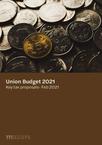Union Budget 2021 I Key tax proposals
AtmaNirbhar Bharat, or the need to become self-reliant, has been an overarching vision that took shape shortly after our initial lockdown. Accordingly, this was also the theme of this year’s budget, which was holistically weaved around six central pillars:
- Health and Wellbeing
- Physical & Financial Capital, and Infrastructure
- Inclusive Development for Aspirational India
- Reinvigorating Human Capital
- Innovation and R&D
- Minimum Government and Maximum Governance
The proposals were largely policy oriented, which stressed upon rejuvenating and strengthening both sectors and institutional frameworks, over the short and long run. There was a strong emphasis on capital expenditure and undertaking digital and cost-efficient measures across a host of value-driven and administrative functions.
COVID-19 has taught us all some big lessons when it comes to managing healthcare systems. While India had undertaken a very creative and intelligible approach as it converted various places into effective treatment-centric hospitals in just days, it had also gotten a reality check for the years to come. It is thereby not surprising that the budget outlay for health and wellbeing jumped up by 137% from last year. Schemes and initiatives such as PM AtmaNirbhar Swasth Bharat Yojana, Mission Poshan 2.0, Jal Jeevan Mission and Urban Swachh Bharat Mission 2.0 exemplify the need to create both proactive and reactive measures toward sustained wellbeing.
Apart from health, a wide range of programs under other pillars are underway in order to promote both life and livelihood in the coming years. Infrastructural development is very much in play, with the budget emphasizing a greater thrust on asset monetization to finance new construction. Meanwhile, dissemination of the promising National Education Policy (NEP), streamlined higher education and strategic research collaborations will foster India to build upon a talented workforce and encourage innovation in many different fields.
From a taxation angle, while there has been no change in slab rates, the government has introduced a slew of hikes in custom duty to encourage Make in India and create a viable playing field for MSMEs.
The fiscal deficit in RE 2020-21 is pegged at 9.5% of GDP, while it is estimated to stand at 6.8% in BE 2021-2022. Fiscal consolidation is underway with the aim to reduce the deficit level below 4.5% of GDP by 2025-2026.
In totality, it is certain to say that this budget, which touched upon core areas of the economy and mandated a model for “repair, reorientation and redevelopment” was much needed at this point of time. There is a strong sense of optimism in the air as we leave the worst behind us. India has the potential to become one of the fastest economies to recover post the pandemic and this budget showcases a blueprint on how we will start to do exactly that.


